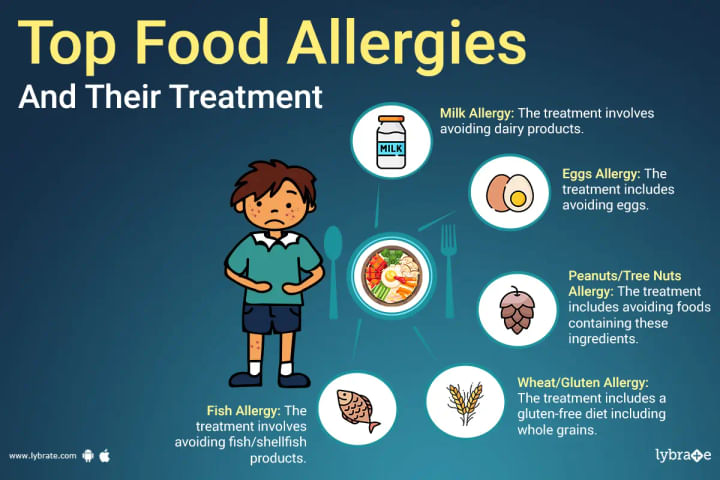The 8 Most Common Food Allergies and their treatment
What are Food Allergies?
A food allergy is an abnormal response to a food triggered by the body's immune system. Almost any food can cause an allergy, but there are some common triggers including nuts, milk, eggs, soy, wheat, shellfish and peanuts.
Symptoms of food allergies range from mild reactions such as a skin rash or stomach ache to severe reactions such as anaphylaxis. Anaphylaxis causes airways to swell shut and can be life threatening if not treated quickly.
What Causes Food Allergies?
- Food allergies are caused by a combination of genetic and environmental factors. For example, people may have inherited genes that make them more likely to develop certain allergic reactions when exposed to certain foods.
- Additionally, exposure to certain substances in the environment or poor dietary habits may increase a person's risk for food allergies.
How Are Food Allergies Diagnosed?
- Food allergies are typically diagnosed with an oral food challenge test or through blood tests that measure specific antibodies against particular foods in the blood serum.
- If these tests show evidence of sensitization (i.e., the presence of antibodies to particular foods), then it is likely that the individual has a food allergy.
- After diagnosis and confirmation testing of suspected allergens has been done it’s very important that patients learn how best to avoid their specific trigger foods and what treatments they should have on-hand in case they do get exposed.
What are the signs and symptoms of Food Allergies?
The signs and symptoms of food allergies can vary widely, but usually involve some combination of hives, rash, itching, difficulty breathing, a decrease in blood pressure and/or tightness in the throat.
Some common symptoms of food allergies include:
- Hives (itchy red spots)
- Swelling in the face or tongue
- Wheezing or breathing difficulties
- Vomiting or abdominal pain
- Itchy skin rashes such as eczema
- Diarrhea
- Runny nose or congestion
- Headache/migraine
- Anaphylaxis (a severe, life threatening allergic reaction)
What are possible Complications of Food Allergies?
- Food allergies can cause serious complications and reactions, ranging in severity from mild to life-threatening.
- Possible complications include skin reactions such as hives, itching or swelling; respiratory symptoms such as coughing, wheezing or shortness of breath; digestive issues such as nausea, vomiting or diarrhoea; and anaphylaxis, a sudden and severe all-body reaction that can be life-threatening.
- People with food allergies must be vigilant in reading food labels to avoid their particular allergens.
The 8 Most Common Food Allergies and their treatment
-
Eggs Allergy: An immune system reaction to proteins in the egg whites or egg yolks. Treatment includes avoiding foods with eggs, as well as taking precautions like carrying and using an injectable epinephrine pen when eating out or travelling.
-
Milk Allergy: An immune system response to the protein in cow's milk. Treatment involves avoiding dairy products, reading labels carefully and finding alternatives like lactose-free and soy milk products.
-
Peanuts/Tree Nuts Allergy: An allergy to peanut or tree nut based products, such as walnuts, almonds or pistachios. Treatment includes avoiding foods containing these ingredients and seeking medical advice if necessary for severe reactions like anaphylaxis shock symptoms (e.g., swelling of the throat and tongue).
-
Wheat/Gluten Allergy: Gluten is a protein found in wheat, rye, barley and other grains that can cause digestive issues for those with wheat allergies or celiac disease (an autoimmune disorder triggered by gluten). Treatment includes following a gluten-free diet including whole grain grains such as quinoa, amaranth and millet, as well as avoiding processed foods that often contain gluten (e.g., breads and pastas).
-
Fish/Shellfish Allergy: Allergies related to substances found in fish skin or shellfish meat or eggs can cause allergic reactions ranging from mild itching around the mouth to life-threatening anaphylactic shock symptoms (e.g., swelling of the throat). Treatment involves avoiding fish/shellfish products altogether or substituting them for non-allergenic foods like tofu depending on severity of reaction(s).
-
Soy Allergy: Allergy to proteins found in soybeans which are used commonly in many ready-made foods such as vegan cheese and certain types of breads/pastas due its high protein content.
-
Mustard Allergy: This allergy is a reaction to mustard seeds & its products that contain mustard, such as mustard powder and prepared mustards. Allergic symptoms can include skin rashes, digestive issues, and anaphylaxis.
-
Sesame Allergy: This allergy is a reaction to sesame seeds & its products that contain sesame, such as tahini. Sesame allergy can cause anaphylaxis.
What are the surgical treatments for Food Allergies?
- Surgical treatments for food allergies are relatively limited. Generally, the focus is not on surgical intervention, but rather on dietary and lifestyle modification to avoid the allergen altogether.
- In severe cases where exposure is likely to occur, such as accidental ingestion in a restaurant or intentional ingestion by a patient with poor compliance with their diet, immunotherapy (OIT) may be recommended by select allergists.
- This entails gradual introduction of small amounts of the allergen into the patient's system to help their body become accustomed and tolerant over time.
- Additionally, endoscopic hydrodissection with topical corticosteroids has recently been used as a potential therapy in certain cases of anaphylaxis, although effects have yet to be proven surefire or long term in nature.
- Endoscopic hydro-dissection: Endoscopic hydro-dissection is a minimally invasive procedure used to help diagnose and manage food allergies. This procedure involves the use of saline and water solution to dissect, identify, and eliminate tissue involved in the allergic reaction. This method can also be used to obtain a sample of the areas affected by allergy for further testing. With endoscopic hydro-dissection, physicians can more accurately diagnose food allergies and identify which foods are causing reactions so they can be avoided in the future.
Best doctors to consult for Food Allergies?
- Allergists: An allergist is a doctor specifically trained to diagnose and treat allergies, asthma, and immunologic disorders. They use skin or blood tests to determine which food(s) is causing an allergic reaction and suggest personalized avoidance strategies.
- Gastroenterologists: Some gastroenterologists may specialize in food allergies unusually severe cases of food intolerance, which involve gastrointestinal difficulties including vomiting, diarrhea and abdominal pain.
- Dietitians: A dietitian can help patients with food allergies create an appropriate meal plan as well as provide dietary advice on how to make sure the diet includes the essential nutrients yet avoids foods that might trigger an allergy attack.



+1.svg)
